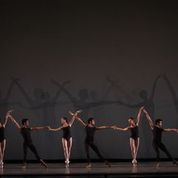|
Back
Agon at a Gathering Miami
Broward Center for the Performing Arts, Fort Lauderdale
10/25/2013 - & October 26*, 27, 2013
George Balanchine: Ballo Della Regina (music by G. Verdi) -
Serenade (music by P. I. Tchaikovsky)
Christopher Wheeldon: Polyphonia (music by G. Ligeti)
Miami City Ballet
Francisco Rennó (piano), Opus One Orchestra, Gary Sheldon (conductor)
Ben Benson, Holly Hynes, Karinska (costume designers), John Hall, Mark Stanley (lighting designers)

Polyphonia (© Daniel Azoulay)
Anyone who had doubts about the direction of Miami City Ballet can put them aside after this opening program. Two of the standards looked as fresh as ever and a work new to the company was performed with the confidence of a staple of the repertory.
The new work got most of the pre-performance attention. It is difficult to know how a community might react to something unfamiliar. Christopher Wheeldon’s brilliant Liturgy was given with tremendous success for at least two seasons, but it only offered a hint of we get in his Polyphonia. Ten piano pieces with very different auras by György Ligeti provide the opportunity for Wheeldon to explore the mathematics of movement along with tremendous insight into the soul. Wheeldon’s vocabulary is grounded in the classical but offers tremendous originality. One might think of this work as Wheeldon’s Agon but it has significantly more personal impact than does Balanchine’s work.
Ligeti is a composer with whom many of us do not feel an immediate bond. The same could be said for much of Stravinsky, too. But the piano pieces selected for Polyphonia perfectly serve the movement and moods. The piece begins and ends with all eight of its dancers following in especially disciplined patterns that seem interrelated. The choreography then moves through duets, trios and even a quartet of cheer and sometimes mystery. The ballet is endlessly original and has a sense of optimism that one might not expect from the music of this composer. The ambiance is further enhanced by the brilliant sensitivity of company pianist Francisco Rennó. John Hall’s lighting design creates thrilling shadows in the opening and closing moments, making the cast seem even bigger. At one point a couple enters and the design creates a set that involves a pathway. Colors stimulate further imagination. I saw this work done twice and even then felt I had only a taste of what was offered. Let us hope that this work is revived regularly. It is obvious that Polphonia will become one of the company’s most requested and beloved ballets.
The Wheeldon piece was bookended by two Balanchine masterworks. The program started with with Ballo Della Regina a work that seems younger with every viewing. Here the corps showed what they are made of and were topped off with the brilliant and ever effervescent Tricia Albertson whose goal is to dazzle us with speed and precision in footwork; it is amazing to imagine the human body can do such a thing in a role which seems seldom airborne. Albertson’s partner was the masculine Kleber Rebello leaping and landing with the grace of an eagle.
For many, the glory of Balanchine is defined by the closing ballet, Serenade. There is nothing like Balanchine’s love for Tchaikovsky, and with this work it never felt so romantic, playful and eventually tragic. Serenade for Strings, with the order of its third and fourth movements changed to give the work a dramatic ending, is the perfect score to display the Balanchine feminine ideal. Though this ballet claims to have no story, it is hard to not invent tales among the flirtations happening before us. The moment of the curtain rising on the corps is one of the most thrilling moments in all of theatre and never fails to make an audience gasp at the simple elegance. And conductor Gary Sheldon who kept things perky with Ballo Della Regina, outdid himself with Serenade, making the orchestra sound bigger yet more intimate at the same time.
This is the sort of perfectly balanced program that should serve as a primer for audience newcomers. There was color, emotion, a variety of moods, and both serious and playful fun. A truly joyous beginning for the season.
Jeff Haller
|